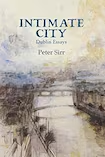
From Dante to Baudelaire, poets have been given to walking around, and Peter Sirr, one of our leading poets, is no different. The stimulating and illuminating essays in this collection are the fruits of his flaneries around Dublin and other cities, but also journeys through time and the internet, a poetic record of the pleasures of what Walter Benjamin called “strolling around in the world”.
Of course, he encounters the literary ghosts of Kavanagh, Behan, Hartnett, Krapp and Bowen. But there is also the ghost of the city itself. On his walks, Sirr traces the original Iron Age routes under the city, converging, according to the late Niall MacCullough, somewhere near Kevin Street. He searches for that famous if intangible place, Ath Cliath, which he calls finely, “a virtual bridge’’.
Reading the book is as full of serendipitous moments as walking around an unfamiliar city. For example, I was delighted to learn that Augustus Saint-Gaudens, the Irish-born sculptor of the Parnell Monument, also made the Shaw Monument on Boston Common, inspiration for Robert Lowell’s great poem, For The Union Dead.
As Sirr walks around he explores the multiple layers of the city, always aware that Dublin is essentially a medieval town. One poignant essay refers to the mindless destruction of the original Viking city by Dublin City Council in 1980, as he ponders Dublin’s shameless appetite for devouring itself. The only consolation, Sirr argues, is that Dubliners have internalised the city – it’s just as well.
There is also a hymn of praise to those rosy-red-bricked streets of Portobello and Phibsborough, where he lovingly describes the details of the slightly different facades, brickworks, windows and footscrapers. These small Victorian streets are like scale versions of the grander Georgian streets, built for, and often embellished by, artisans and craftsmen. Sirr refers to the 1911 census for the residents of Geraldine Street, and finds a multitude of professions, ranging from carpenters and charwomen to cattle dealers and policemen.
The question implicit in his description is why, with all our resources, we now seem incapable of building beautiful and affordable housing for ordinary people? What should a living city look like? As the poet wanders the Georgian city, he notes how the core of the city has become hollowed out and uninhabited. When he stops at one of its most beautiful corners he sees “the barbarian Starbucks behind the Church where I badly want to queue up and say, a flat white and a sledgehammer please”.
A partial answer comes in the scathing, densely researched essay on the history of the docklands. When he tries to take a photograph of Mayor Street, a security guard runs to him and says “photography is strictly forbidden”. When the poet inquires why, he is told that “clients wouldn’t like it”. “The ‘clients’, whoever they were, were the real occupants of docklands. The rest of us were visitors.”
This book is required reading for every Dubliner.















